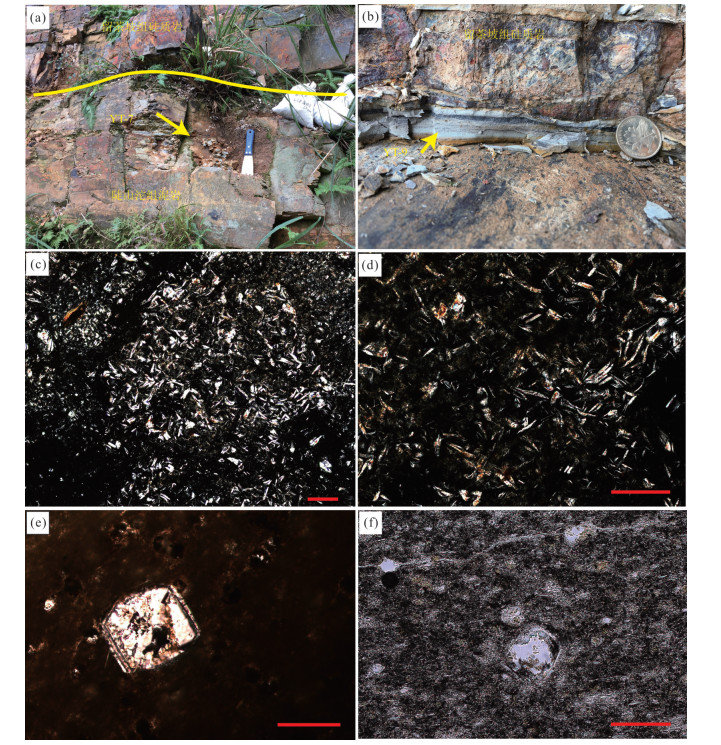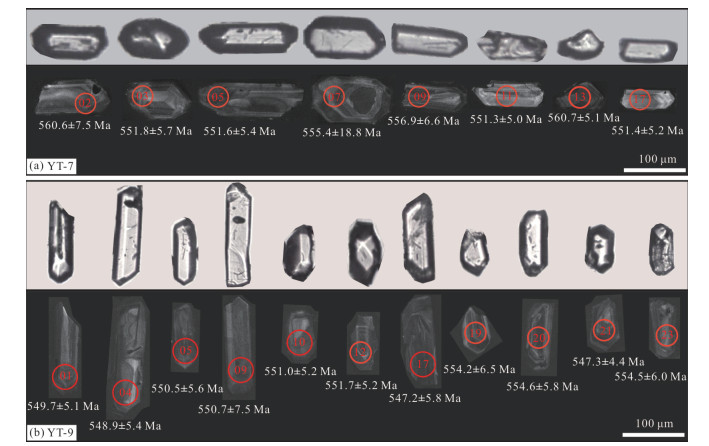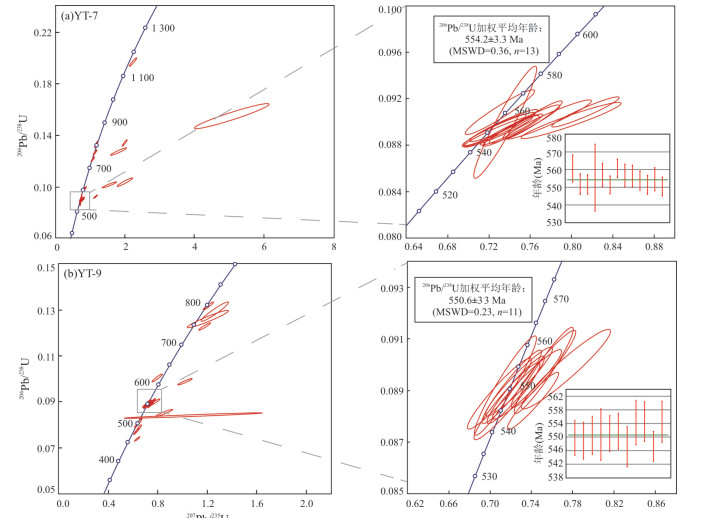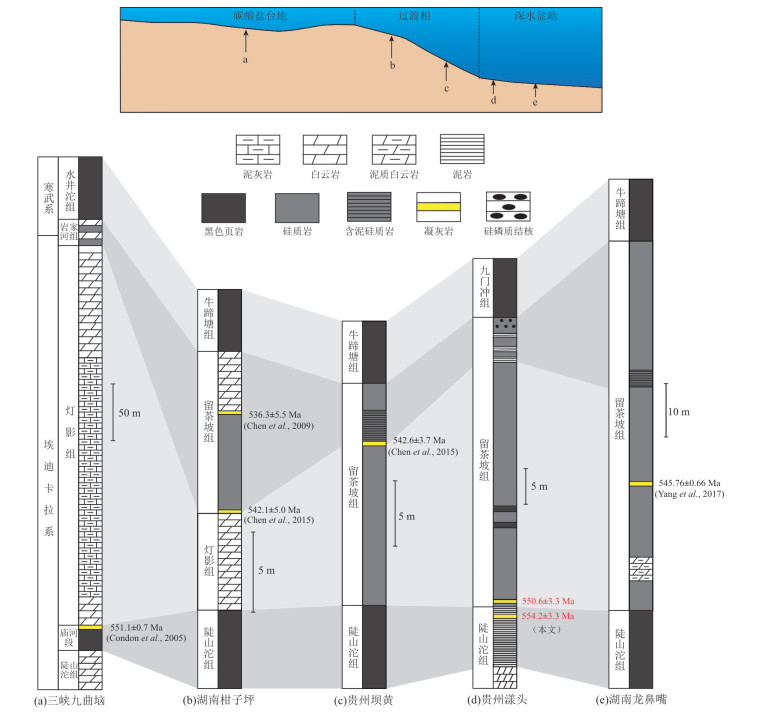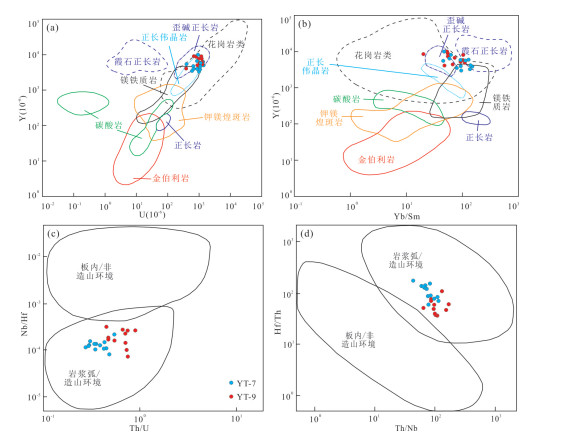Zircon U-Pb Ages and Its Geological Significance of Tuffs between Doushantuo and Liuchapo Formations at Yangtou Section, Guizhou Province
-
摘要: 前寒武纪-寒武纪过渡时期是地质历史上最重要的转折期之一,对这一时期不同沉积相地层建立精确的对比标志,是理解寒武纪动物大爆发等一系列重大地质问题的关键.对贵州漾头剖面陡山沱组顶部和留茶坡组底部的两层凝灰岩中的锆石进行了LA-ICP-MS U-Pb年代学研究,分别获得了554.2±3.3 Ma和550.6±3.3 Ma的加权平均年龄,证明华南扬子地台深水相区留茶坡组开始沉积的时间约为550 Ma.扬子地台在埃迪卡拉纪-寒武纪过渡时期存在明显的台-盆沉积相分异,表明扬子地台在这一时期进入拉张的构造背景;因此,留茶坡组底部550.6±3.3 Ma的绝对年龄代表了扬子地台进入伸展构造背景和强烈海底热液活动开始的时间.另外,凝灰岩锆石微量元素特征显示,两层凝灰岩的源岩均属于花岗岩类,形成的大地构造背景属于岛弧环境或造山环境.Abstract: The Precambrian-Cambrian transition is one of the most important periods in the geological history. Establishing precise stratigraphic correlations among different sedimentary facies lays the foundation for deciphering important geological events including the Cambrian Explosion. LA-ICP-MS U-Pb zircon geochronology was carried out for the two tuffs in the upmost Doushantuo Formation and the basal Liuchapo Formation at the Yangtou section, Guizhou Province in this study. The weighted mean ages of the two tuffs are 554.2±3.3 Ma and 550.6±3.3 Ma, respectively. The new data suggests that the deposition time of the Liuchapo Formation in the deep-water facies of the Yangtze Platform is about 550 Ma. During the Ediacaran-Cambrian transition, the distinct differentiation of deposite facies across the Yangtze Platform indicates that the Yangtze Platform turned into extensional setting during this period. Therefore, the age of 550.6±3.3 Ma at the basal Liuchapo Formation also represents the time when the Yangtze Platform turned into the extensional setting and intense hydrothermal activities. In addition, trace elements of zircons indicate that the two tuffs derived from granite which formed in the magmatic arc or the orogenic environment.
-
Key words:
- Yangtze Platform /
- deep-water basin /
- stratigraphy correlation /
- zircon U-Pb age /
- geochronology /
- trace element
-
图 1 华南扬子地台埃迪卡拉纪-寒武纪过渡时期古地理图(a)、漾头剖面及周边地质简图(b)和漾头剖面地层柱状图(c)
图a修改自Jiang et al.(2011)
Fig. 1. Simplified paleographic map of the South China during the Ediacaran-Cambrian transition(a), geological map of the Yangtou section and surrounding areas (b)and stratigraphic column of the Yangtou section(c)
图 6 漾头剖面凝灰岩锆石微量元素特征判别图
图a、b的底图据Belousova et al.(2002);图c、d的底图据Yang et al.(2012)
Fig. 6. Zircon trace element plots of tuffs at the Yangtou section
-
An, Z. H., Jiang, G. Q., Tong, J. N., et al., 2015. Stratigraphic Position of the Ediacaran Miaohe Biota and Its Constrains on the Age of the Upper Doushantuo δ13C Anomaly in the Yangtze Gorges Area, South China. Precambrian Research, 271: 243-253. https://doi.org/10.1016/j.precamres.2015.10.007 Belousova, E., Griffin, W., O'Reilly, S. Y., et al., 2002. Igneous Zircon: Trace Element Composition as an Indicator of Source Rock Type. Contributions to Mineralogy and Petrology, 143(5): 602-622. https://doi.org/10.1007/s00410-002-0364-7 Chang, H.J., Chu, X.L., Feng, L.J., et al., 2010. The Major and REE Geochemistry of the Silikou Chert in Northern Guangxi Province. Acta Sedimentologica Sinica, 28(6): 1098-1107 (in Chinese with English abstract). http://www.wanfangdata.com.cn/details/detail.do?_type=perio&id=cjxb201006007 Chang, H. J., Chu, X. L., Feng, L. J., et al., 2009. Terminal Ediacaran Anoxia in Deep-Ocean: Trace Element Evidence from Cherts of the Liuchapo Formation, South China. Science China Earth Sciences, 52(6): 807-822. https://doi.org/10.1007/s11430-009-0070-7 Chang, H.J., Chu, X.L., Feng, L.J., et al., 2008. REE Geochemistry of the Liuchapo Chert in Anhua, Hunan. Geology in China, 35(5): 879-887 (in Chinese with English abstract). http://www.wanfangdata.com.cn/details/detail.do?_type=perio&id=zgdizhi200805009 Chang, S., Feng, Q.L., Zhang, L, 2018. New Siliceous Microfossils from the Terreneuvian Yanjiahe Formation, South China: The Possible Earliest Radiolarian Fossil Record. Journal of Earth Science, 29(4): 912-919. https://doi.org/10.1007/s12583-017-0960-0 Chen, D. Z., Wang, J. G., Qing, H. R., et al., 2009. Hydrothermal Venting Activities in the Early Cambrian, South China: Petrological, Geochronological and Stable Isotopic Constraints. Chemical Geology, 258(3-4): 168-181. https://doi.org/10.1016/j.chemgeo.2008.10.016 Chen, D. Z., Zhou, X. Q., Fu, Y., et al., 2015. New U-Pb Zircon Ages of the Ediacaran-Cambrian Boundary Strata in South China. Terra Nova, 27(1): 62-68. https://doi.org/10.1111/ter.12134 Compston, W., Zhang, Z., Cooper, J. A., et al., 2008. Further SHRIMP Geochronology on the Early Cambrian of South China. American Journal of Science, 308(4): 399-420. https://doi.org/10.2475/04.2008.01 Condon, D., Zhu, M.Y., Bowring, S., et al., 2005. U-Pb Ages from the Neoproterozoic Doushantuo Formation, China. Science, 308(5718): 95-98. https://doi.org/10.1126/science.1107765 Dong, L., Shen, B., Lee, C. T. A., et al., 2015. Germanium/Silicon of the Ediacaran-Cambrian Laobao Cherts: Implications for the Bedded Chert Formation and Paleoenvironment Interpretations. Geochemistry, Geophysics, Geosystems, 16(3): 751-763. https://doi.org/10.1002/2014gc005595 Dong, L., Xiao, S. H., Shen, B., et al., 2008. Silicified Horodyskia and Palaeopascichnus from Upper Ediacaran Cherts in South China: Tentative Phylogenetic Interpretation and Implications for Evolutionary Stasis. Journal of the Geological Society, 165(1): 367-378. https://doi.org/10.1144/0016-76492007-074 Fan, H. F., Wen, H. J., Zhu, X. K., et al., 2013. Hydrothermal Activity during Ediacaran-Cambrian Transition: Silicon Isotopic Evidence. Precambrian Research, 224: 23-35. https://doi.org/10.1016/j.precamres.2012.09.004 Font, E., Nédélec, A., Trindade, R. I. F., et al., 2010. Fast or Slow Melting of the Marinoan Snowball Earth? The Cap Dolostone Record. Palaeogeography, Palaeoclimatology, Palaeoecology, 295(1-2): 215-225. https://doi.org/10.1016/j.palaeo.2010.05.039 Grimes, C. B., John, B. E., Kelemen, P. B., et al., 2007. Trace Element Chemistry of Zircons from Oceanic Crust: A Method for Distinguishing Detrital Zircon Provenance. Geology, 35(7): 643-646. https://doi.org/10.1130/g23603a.1 Guo, Q. J., Shields, G. A., Liu, C. Q., et al., 2007. Trace Element Chemostratigraphy of Two Ediacaran-Cambrian Successions in South China: Implications for Organosedimentary Metal Enrichment and Silicification in the Early Cambrian. Palaeogeography, Palaeoclimatology, Palaeoecology, 254(1-2): 194-216. https://doi.org/10.1016/j.palaeo.2007.03.016 Han, T., Fan, H. F., Zhu, X. Q., et al., 2017. Submarine Hydrothermal Contribution for the Extreme Element Accumulation during the Early Cambrian, South China. Ore Geology Reviews, 86: 297-308. https://doi.org/10.1016/j.oregeorev.2017.02.030 Hoskin, P. W. O., Ireland, T. R., 2000. Rare Earth Element Chemistry of Zircon and Its Use as a Provenance Indicator. Geology, 28(7): 627-630. https://doi.org/10.1130/0091-7613(2000)28627:reecoz>2.0.co; 2 doi: 10.1130/0091-7613(2000)28627:reecoz>2.0.co;2 Huang, T.Y., Chen, D.Z., Ding, Y., et al., 2020. SIMS U-Pb Zircon Geochronological and Carbon Isotope Chemostratigraphic Constraints on the Ediacaran-Cambrian Boundary Succession in the Three Gorges Area, South China. Journal of Earth Science, 31(1): 69-78. https://doi.org/10.1007/s12583-019-1233-x Jiang, G. Q., Shi, X. Y., Zhang, S. H., et al., 2011. Stratigraphy and Paleogeography of the Ediacaran Doushantuo Formation (ca. 635-551 Ma) in South China. Gondwana Research, 19(4): 831-849. https://doi.org/10.1016/j.gr.2011.01.006 Liu, Y. S., Hu, Z. C., Gao, S., et al., 2008. In Situ Analysis of Major and Trace Elements of Anhydrous Minerals by LA-ICP-MS without Applying an Internal Standard. Chemical Geology, 257(1-2): 34-43. https://doi.org/10.1016/j.chemgeo.2008.08.004 Liu, Y. S., Hu, Z. C., Zong, K. Q., et al., 2010. Reappraisement and Refinement of Zircon U-Pb Isotope and Trace Element Analyses by LA-ICP-MS. Chinese Science Bulletin, 55(15): 1535-1546. https://doi.org/10.1007/s11434-010-3052-4 Ludwig, K.R., 2003. Using ISOPLOT/Ex: A Geochronological Toolkit for Microsoft Excel Version 3.0. Berkeley Geochronology Center, Berkeley, 1-40. Okada, Y., Sawaki, Y., Komiya, T., et al., 2014. New Chronological Constraints for Cryogenian to Cambrian Rocks in the Three Gorges, Weng'an and Chengjiang Areas, South China. Gondwana Research, 25(3): 1027-1044. https://doi.org/10.1016/j.gr.2013.05.001 Peng, J., Xu, W.G., 2001. Geochemical Characteristics of Depositional Environment of the Upper Sinian Bedded Siliceous Rock in Western Hunan. Geochimica, 30(3): 293-298 (in Chinese with English abstract). http://en.cnki.com.cn/Article_en/CJFDTOTAL-DQHX200103012.htm Rubatto, D., 2002. Zircon Trace Element Geochemistry: Partitioning with Garnet and the Link between U-Pb Ages and Metamorphism. Chemical Geology, 184(1-2): 123-138. https://doi.org/10.1016/s0009-2541(01)00355-2 Shu, D. G., Isozaki, Y., Zhang, X. L., et al., 2014. Birth and Early Evolution of Metazoans. Gondwana Research, 25(3): 884-895. https://doi.org/10.1016/j.gr.2013.09.001 Wang, G. Z., Wang, J. S., Wang, Z., et al., 2017. Carbon Isotope Gradient of the Ediacaran Cap Carbonate in the Shennongjia Area and Its Implications for Ocean Stratification and Palaeogeography. Journal of Earth Science, 28(2): 187-195. https://doi.org/10.1007/s12583-016-0923-x Wang, J., Li, Z.X., 2003. History of Neoproterozoic Rift Basins in South China: Implications for Rodinia Break-Up. Precambrian Research, 122(1-4): 141-158. https://doi.org/10.1016/s0301-9268(02)00209-7 Wang, J. G., Chen, D. Z., Wang, D., et al., 2012. Petrology and Geochemistry of Chert on the Marginal Zone of Yangtze Platform, Western Hunan, South China, during the Ediacaran-Cambrian Transition. Sedimentology, 59(8): 809-829. https://doi.org/10.1111/j.13653091.2011.01280.x Wang, J.G., Chen, D.Z., Yan, D.T., et al., 2011. Sharp Transition from Carbonates to Cherts across the Platform Margin in Western Hunan, South China during Precambrian-Cambrian Transition:Stratal-Depositional Patterns, Mechanisms and Implications. Chinese Journal of Geology, 46(1): 27-41 (in Chinese with English abstract). http://en.cnki.com.cn/Article_en/CJFDTotal-DZKX201101005.htm Wang, X. Q., Shi, X. Y., Jiang, G. Q., et al., 2012. New U-Pb Age from the Basal Niutitang Formation in South China: Implications for Diachronous Development and Condensation of Stratigraphic Units across the Yangtze Platform at the Ediacaran-Cambrian Transition. Journal of Asian Earth Sciences, 48: 1-8. https://doi.org/10.1016/j.jseaes.2011.12.023 Wang, Y., Huang, Z.Q., Chen, H.D., et al., 2012. Stratigraphical Correlation of the Liuchapo Formation with the Dengying Formation in South China. Journal of Jilin University (Earth Science Edition), 42(S1): 328-335 (in Chinese with English abstract). doi: 10.1007/978-3-642-27708-5_66 Wu, Y.B., Zheng, Y.F., 2004. Genesis of Zircon and Its constraints on Interpretation of U-Pb Age. Chinese Science Bulletin, 49(16): 1589-1604 (in Chinese). doi: 10.1360/csb2004-49-16-1589 Xu, Y. J., Cawood, P. A., Du, Y. S., et al., 2014. Terminal Suturing of Gondwana along the Southern Margin of South China Craton: Evidence from Detrital Zircon U-Pb Ages and Hf Isotopes in Cambrian and Ordovician Strata, Hainan Island. Tectonics, 33(12): 2490-2504. https://doi.org/10.1002/2014tc003748 Xue, Y.S., Tang, T.F., Yu, C.L., 1989. Division and Correlation of the Late Sinian Strata in Southern Anhui and Western Hunan. Journal of Stratigraphy, 13(1):52-58 (in Chinese with English abstract). http://en.cnki.com.cn/Article_en/CJFDTOTAL-DCXZ198901008.htm Yang, C., Zhu, M. Y., Condon, D. J., et al., 2017. Geochronological Constraints on Stratigraphic Correlation and Oceanic Oxygenation in Ediacaran-Cambrian Transition in South China. Journal of Asian Earth Sciences, 140: 75-81. https://doi.org/10.1016/j.jseaes.2017.03.017 Yang, E.L., Chen, H.S., Chen, H., et al., 2011. Elemental Geochemistry and Sedimentary Environment of the Liuchapo Siliceous Rocks in Songtao-Cengong-Sandu, Eastern Guizhou Province. Acta Mineralogica Sinia, 31(3): 406-411(in Chinese with English abstract). http://d.old.wanfangdata.com.cn/Periodical/kwxb201103013 Yang, J. H., Cawood, P. A., Du, Y. S., et al., 2012. Large Igneous Province and Magmatic Arc Sourced Permian-Triassic Volcanogenic Sediments in China. Sedimentary Geology, 261-262: 120-131. https://doi.org/10.1016/j.sedgeo.2012.03.018 Yin, G.Z., Wang, Y.G., Qian, Y., 1982. A Preliminary Study for the Sinian-Cambrian Boundary in Guizhou. Journal of Stratigraphy, 6(4): 286-293 (in Chinese). Zhang, J.M., Li, G.X., Zhou, C.M., 1997.Geochemistry of Light Colour Clayrock Layers from the Early Cambrian Meishucun Stage in Eastern Yunnan and Their Geological Significance. Acta Petrologica Sinica, 13(1): 101-110 (in Chinese with English abstract). http://en.cnki.com.cn/Article_en/CJFDTOTAL-YSXB701.008.htm Zhao, G. C., Wang, Y. J., Huang, B. C., et al., 2018. Geological Reconstructions of the East Asian Blocks: From the Breakup of Rodinia to the Assembly of Pangea. Earth-Science Reviews, 186: 262-286. https://doi.org/10.1016/j.earscirev.2018.10.003 Zhao, X.K., Shi, X.Y., Wang, X.Q., et al., 2018. Stepwise Oxygenation of Early Cambrian Ocean Drove Early Metazoan Diversification. Earth Science, 43(11):3873-3890 (in Chinese with English abstract). http://d.old.wanfangdata.com.cn/Periodical/dqkx201811006 Zhou, M. Z., Luo, T. Y., Li, Z. X., et al., 2008. SHRIMP U-Pb Zircon Age of Tuff at the Bottom of the Lower Cambrian Niutitang Formation, Zunyi, South China. Chinese Science Bulletin, 53(1): 104-110 (in Chinese). doi: 10.1360/csb2008-53-1-104 Zhou, M.Z., Luo, T.Y., Liu, S.R., et al., 2013. SHRIMP Zircon Age for a K-Bentonite in the Top of the Laobao Formation at the Pingyin Section, Guizhou, South China. Scientia Sinica Terrae, 43(7): 1195-1206 (in Chinese). doi: 10.1360/zd-2013-43-7-1195 Zhou, M.Z., Luo, T.Y., Huff, W. D., et al., 2014. Prominent Lower Cambrian K-Bentonites in South China: Distribution, Mineralogy, and Geochemistry. Journal of Sedimentary Research, 84(10): 842-853. https://doi.org/10.2110/jsr.2014.66 Zhou, M. Z., Luo, T. Y., Huff, W. D., et al., 2018. Timing the Termination of the Doushantuo Negative Carbon Isotope Excursion: Evidence from U-Pb Ages from the Dengying and Liuchapo Formations, South China. Science Bulletin, 63(21): 1431-1438. https://doi.org/10.1016/j.scib.2018.10.002 Zhu, M.Y., Zhang, J.M., Steiner, M., et al., 2003. Sinian-Cambrian Stratigraphic Framework for Shallow- to Deep-Water Environments of the Yangtze Platform: An Integrated Approach. Progress in Natural Science, 13(12): 951-960. https://doi.org/10.1080/10020070312331344710 Zhuo, J.W., Wang, Z.J., Wang, J., et al., 2009. SHRIMP Zircon U-Pb Age of Crystal Tuffs on the Top of Sinian Laobao Formation at Bahuang, Tongren Area, and Its Geological Implications. Geological Review, 55(5): 639-646 (in Chinese with English abstract). http://www.wanfangdata.com.cn/details/detail.do?_type=perio&id=dzlp200905005 Zong, K. Q., Klemd, R., Yuan, Y., et al., 2017. The Assembly of Rodinia: The Correlation of Early Neoproterozoic (ca. 900 Ma) High-Grade Metamorphism and Continental Arc Formation in the Southern Beishan Orogen, Southern Central Asian Orogenic Belt (CAOB). Precambrian Research, 290: 32-48. https://doi.org/10.1016/j.precamres.2016.12.010 常华进, 储雪蕾, 冯连君, 等, 2008.湖南安化留茶坡硅质岩的REE地球化学特征及其意义.中国地质, 35(5):879-887. doi: 10.3969/j.issn.1000-3657.2008.05.009 常华进, 储雪蕾, 冯连君, 等, 2010.桂北泗里口老堡组硅质岩的常量、稀土元素特征及成因指示.沉积学报, 28(6):1098-1107. doi: 10.1007-s10439-010-0026-2/ 彭军, 徐望国, 2001.湘西上震旦统层状硅质岩沉积环境的地球化学标志.地球化学, 30(3):293-298. doi: 10.3321/j.issn:0379-1726.2001.03.013 汪建国, 陈代钊, 严德天, 等, 2011.湘西地区前寒武纪-寒武纪转折期碳酸盐-硅泥质沉积体系的截然转换:地层-沉积样式, 形成机理及意义.地质科学, 46(1): 27-41. doi: 10.3969/j.issn.0563-5020.2011.01.004 王约, 黄再琴, 陈洪德, 等, 2012.华南留茶坡组与灯影组的地层对比.吉林大学学报(地球科学版), 42(S1):328-335. http://www.cnki.com.cn/Article/CJFDTotal-CCDZ2012S1037.htm 吴元保, 郑永飞, 2004.锆石成因矿物学研究及其对U-Pb年龄解释的制约.科学通报, 49(16): 1589-1604. doi: 10.3321/j.issn:0023-074X.2004.16.002 薛耀松, 唐天福, 俞从流, 1989.皖南与湘西晚震旦世地层的划分与对比.地层学杂志, 13(1): 52-58. http://www.cqvip.com/QK/92920X/198901/14768.html 杨恩林, 陈恨水, 陈焕, 等, 2011.黔东留茶坡组硅质岩元素地球化学特征与形成环境.矿物学报, 31(3):406-411. http://d.old.wanfangdata.com.cn/Periodical/kwxb201103013 尹恭正, 王砚耕, 钱逸, 1982.贵州震旦系与寒武系分界的初步研究.地层学杂志, 6(4): 286-293. http://www.cnki.com.cn/Article/CJFDTotal-DCXZ198204005.htm 张俊明, 李国祥, 周传明, 1997.滇东早寒武世梅树村期浅色粘土岩层的地球化学特征和地质意义.岩石学报, 13(1):101-110. http://www.cqvip.com/QK/94579X/19971/2447174.html 赵相宽, 史晓颖, 王新强, 等, 2018.寒武纪早期海洋阶段性氧化驱动早期后生动物多样化进程.地球科学, 43(11):3873-3890. doi: 10.3799/dqkx.2018.143 周明忠, 罗泰义, 李正祥, 等, 2008.遵义牛蹄塘组底部凝灰岩锆石SHRIMP U-Pb年龄及其地质意义.科学通报, 53(1): 104-110. doi: 10.3321/j.issn:0023-074X.2008.01.018 周明忠, 罗泰义, 刘世荣, 等, 2013.贵州江口平引老堡组顶部的锆石SHRIMP年龄与对比意义.中国科学:地球科学, 43(7): 1195-1206. http://www.wanfangdata.com.cn/details/detail.do?_type=perio&id=zgkx-cd201307013 卓皆文, 汪正江, 王剑, 等, 2009.铜仁坝黄震旦系老堡组顶部晶屑凝灰岩SHRIMP锆石U-Pb年龄及其地质意义.地质论评, 55(5): 639-646. http://d.old.wanfangdata.com.cn/Periodical/dzlp200905005 -
 陈灿附表.docx
陈灿附表.docx

-









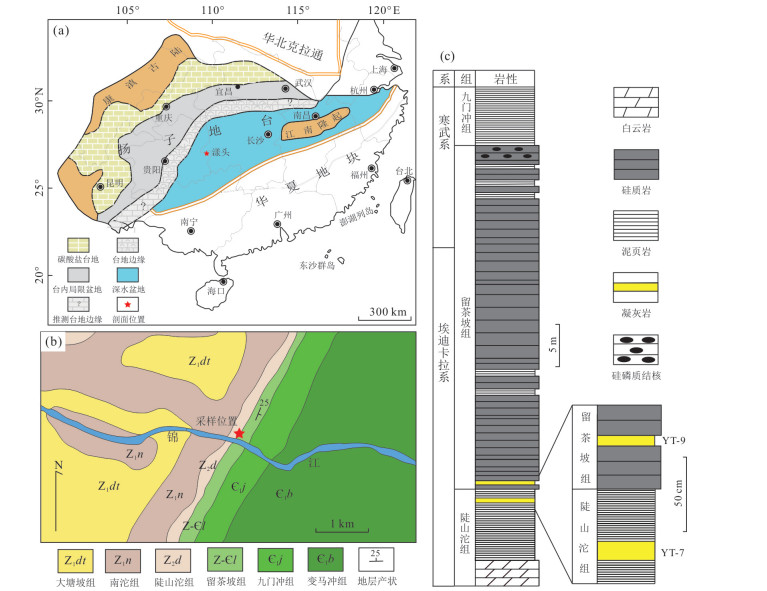
 下载:
下载:
